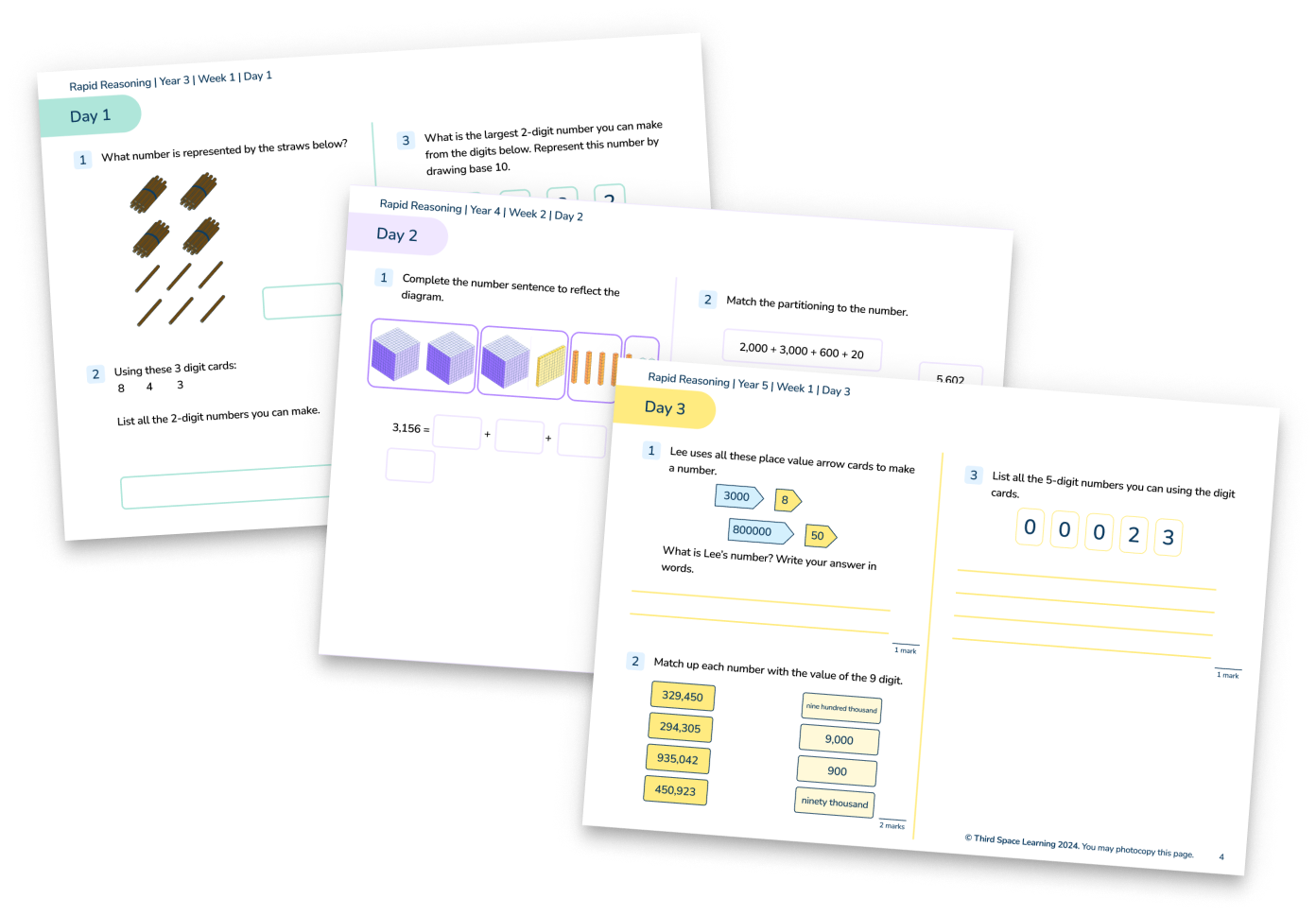2-Step Word Problems and Multi-Step Word Problems in KS2 Maths: Sample Questions, Answers & Strategies for Solving
Teaching your pupils to solve 2-step word problems and multi-step word problems at KS2 is one of hardest parts of a mastery led approach in maths. There are several cognitive functions at play, as children have to wrestle with their knowledge of maths vocabulary, maths operations, and often basic comprehension skills.
In this article we set out some of the sorts of maths word problems pupils can expect from the KS2 maths national curriculum and look at strategies for solving them. In total we’ve provided 30 KS2 word problems to work through, showing the variety of 2-step word problems and multi-step word problems pupils are likely to encounter.
- What are word problems
- What are two-step word problems?
- What are multi-step word problems?
- Two-step word problems and multi-step word problems pupils will encounter in KS2
- Skills required for multi-step word problems
- Arithmetic within multi-step word problems
- How to teach multi-step word problems
- How to solve a year 6 multi-step word problem
- How to solve a year 5 multi-step word problem
- 2-step word problems Year 3
- 2-step word problems Year 4
- Multi-step word problems: Year 5
- Multi-step word problems Year 6
- 2-step and multi-step word problems by topic
- Place value word problems
- Addition and subtraction word problems
- Multiplication and division word problems
- Mixed operations word problems
- Fraction word problems
- Decimals word problems
- Percentage word problems
- Measurement word problems
- Money word problems
- Area word problems
- Perimeter word problems
- Ratio word problems
- Order of operations word problems
- Volume word problems
- Algebra word problems
- More support with KS2 word problems
What are word problems
Word problems in maths are sentences describing a real life scenario where children must apply their maths knowledge to reach a solution or unpick the maths problem.
To solve maths word problems children must be familiar with the maths language associated with the mathematical symbols they are used to in order to make sense of the word problem; for example: plus, more, total = add; difference, less, minus = subtract, etc.
What are two-step word problems?
Two-step word problems are problems in which two separate calculations (usually different operations) are required to reach the answer. By different operations we mean addition, subtraction, multiplication or division.
What are multi-step word problems?
Multi-step word problems are maths problems that require multiple calculations to solve them. They will usually will involve more than one operation and often more than one strand from the curriculum. For example a multi-step word problem on area and perimeter may also involve ratio and multiplication.
In KS2 SATs multi-step word problems can be awarded up to 3 marks for a correct answer, but 1 or 2 marks can be achieved by solving some of the steps in the problem correctly.
If you have any pupils who are struggling to master word problems, they may need a more intensive, personalised intervention. Third Space Learning provides AI maths tutoring with Skye, the AI tutor, as a high-quality, scalable intervention. Skye’s tutoring follows a rigorous step-by-step process designed by maths experts, with an emphasis on encouraging pupils to verbalise their thinking. Pupils make on average double their expected progress with us.
Two-step word problems and multi-step word problems pupils will encounter in KS2
In Key Stage 2, there are nine ‘strands’ of maths – these are then further split into ‘sub-strands’. For example, ‘number and place value’ is the first strand: a Year 3 sub-strand of this is to “find 10 or 100 more or less than a given number”; a Year 6 sub-strand of this is to “determine the value of each digit in numbers up to 10 million”.
The table below shows how the ‘sub-strands’ are distributed across each strand and year group in KS2.
| Strand | Year 3 | Year 4 | Year 5 | Year 6 | Total |
| Number and place value | 6 | 9 | 5 | 7 | 27 |
| Calculations | 7 | 8 | 15 | 9 | 39 |
| Fractions, decimals and percentages | 7 | 10 | 12 | 11 | 40 |
| Ratio and proportion | 0 | 0 | 0 | 4 | 4 |
| Algebra | 0 | 0 | 0 | 5 | 5 |
| Measurement | 17 | 9 | 10 | 8 | 44 |
| Geometry: properties of shape | 5 | 4 | 6 | 7 | 22 |
| Geometry: position and direction | 0 | 3 | 1 | 2 | 6 |
| Statistics | 2 | 2 | 2 | 2 | 8 |
As well as varying in content (sometimes by using a combination of strands in one problem, e.g. shape and calculations), word problems will also vary in complexity, from one-step to multi-step problems.
Different word problems will provide a different level of cognitive demand as an alternative method of adapting the level of difficulty. The STA mathematics test framework (2015) sets these out.
| Strand | 1 | 2 | 3 | 4 |
| Depth of understanding | recall of facts or application of procedures | use facts and procedures to solve simple problems | use facts and procedures to solve more complex problems | understand and use facts and procedures creatively to solve complex or unfamiliar problems |
| Computational complexity | no numeric steps | one, or a small number of numeric steps | a larger number of numeric steps all steps are simple | a larger number of numeric steps, at least one of which is more complex |
| Spatial reasoning | no spatial reasoning required | manipulation of the geometric information is required | complex manipulation of the geometric information is required | interpret, infer or generate new geometric information |
| Data interpretation | no data interpretation required | select and retrieve information | select and interpret information | generate or infer new information from data |
| Response strategy | select one or more responses or construct a simple response | construct a small set of responses | construct a straightforward explanation shows evidence of a method | construct a complex explanation |
Skills required for multi-step word problems
There is a high level of cognitive demand on children when they are faced with multi-step word problems: interpreting the question to find the arithmetic behind it and then calculating the arithmetic itself.
Therefore, a secure knowledge of times tables and a confident understanding of arithmetic are essential skills for being able to successfully solve word problems.
Year 3 to 6 Rapid Reasoning (Weeks 1-6)
Download 480 two-step and multi-step word problems for Years 3 to Year 6 (4 a day x 6 weeks for each year group)
Download Free Now!Arithmetic within multi-step word problems
A useful strategy to use in class is to provide children with a list of arithmetic questions you have previously ‘extracted’ from some word problems.
Generally, children are much more confident with arithmetic than word problems, so they should be able to answer these with relative ease.
In the next lesson, give the children the word problems – after a while, ask them which they found easier and why.
Then show the children the arithmetic from the previous day and ask if they can see the similarities. They could then try to ‘extract’ the arithmetic from word problems themselves.
How to teach multi-step word problems
Here are two simple strategies that can be applied to most two-step word problems and multi-step word problems before solving them.
- What do you already know?
- How can this problem be drawn/represented pictorially?
How to solve a year 6 multi-step word problem
Here’s an example.
There are 29 pupils in a class. The teacher has 7 litres of apple juice. She pours 215 millilitres of apple juice for every pupil. How much apple juice is left over?
1. What do you already know?
- There are 1,000ml in 1 litre
- Pours = liquid leaving the bottle = subtraction
- For every = multiply
- Left over = requires subtraction at some point
2. How can this problem be drawn/represented pictorially?
Bar modelling is always a brilliant way of representing even multi step word problems in year 6, but there are always other ways of drawing it out. For example, for this question, you could draw 29 pupils (or stick man x 29) with ‘215 ml’ above each one and then a half-empty bottle with ‘7 litres’ marked at the top.
Now to put the maths to work. This is a Year 6 multi-step problem, so we need to use what we already know and what we’ve drawn to break down the steps.
3. How to answer step by step
- There are 29 pupils in a class.
- The teacher has 7 litres of apple juice. 1) 7 litres = 7,000ml
- She pours 215 millilitres of apple juice for every pupil. 2) 215ml x 29 = 6,235ml
- How much apple juice is left over? 3) 7,000ml – 6,235ml = 765ml
How to solve a year 5 multi-step word problem
A similar approach can be used for this one.
- Mara is in a bookshop. She buys one book for £6.99 and another that costs £3.40 more than the first book. She pays using a £20 notes. What change does Mara get?
1. What do you already know?
- More than = add
- Using decimals means I will have to line up the decimal points correctly in calculations
- Change from money = subtract
2. How can this problem be drawn/represented pictorially?
See this example of bar modelling for this question:
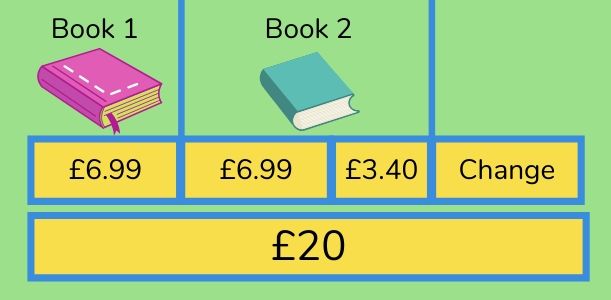
Now to put the maths to work using what we already know and what we’ve drawn to break down the steps.
3. How to answer step by step
- Mara is in a bookshop.
- She buys one book for £6.99 and another that costs £3.40 more than the first book. 1) £6.99 + (£6.99 + £3.40) = £17.38
- She pays using a £20 note.
- What change does Mara get?
- £20 – £17.38 = £2.62
There are plenty more teacher guides and resources available from Third Space for problem solving in KS2. Find out how to develop maths reasoning skills in KS2, how to balance fluency, reasoning and problem solving in your maths lessons, and get ideas for developing and running maths investigations at KS2.
2-step word problems Year 3
With word problems for Year 3, children will move away from solely using concrete resources when solving word problems and start using written methods. This is also the year in which two-step problems will be introduced.
As some children may not be confident readers, it is important that word problems are explored in a variety of contexts: as a class, in groups, in partners, with an adult, with a list of ‘mathematical vocabulary’ accessible, etc. It is important that children’s literacy skills don’t hinder their progress or in maths.
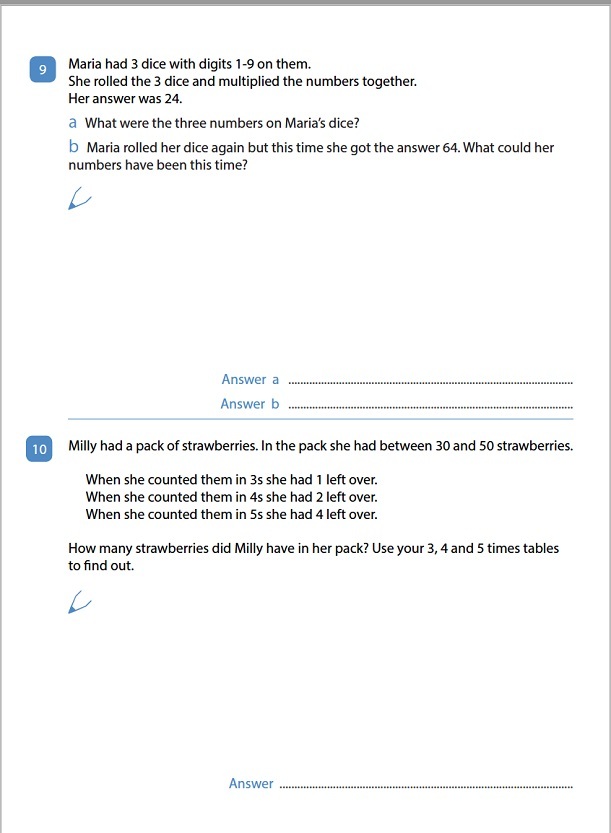
Example Year 3 word problems

- Dylan and Holly have different amounts of money. Dylan has fifteen 2p coins. Holly has seven 5p coins. Who has the most money, and by how much? Answer: Holly by 5p.
- It takes Jamie 10 minutes to read 3 pages of his book. He reads 18 pages of his book before bed. How long does Jamie spend reading? Answer: 60 minutes.
2-step word problems Year 4
With word problems year 4, children should feel confident using the written method for each of the four operations. This year children will be presented with a variety of problems, including two-step problems, and be expected to work out the appropriate method required to solve each one.
While children should be focusing on formal written methods, it is important that concrete resources and pictorial representations are still used to consolidate their understanding.
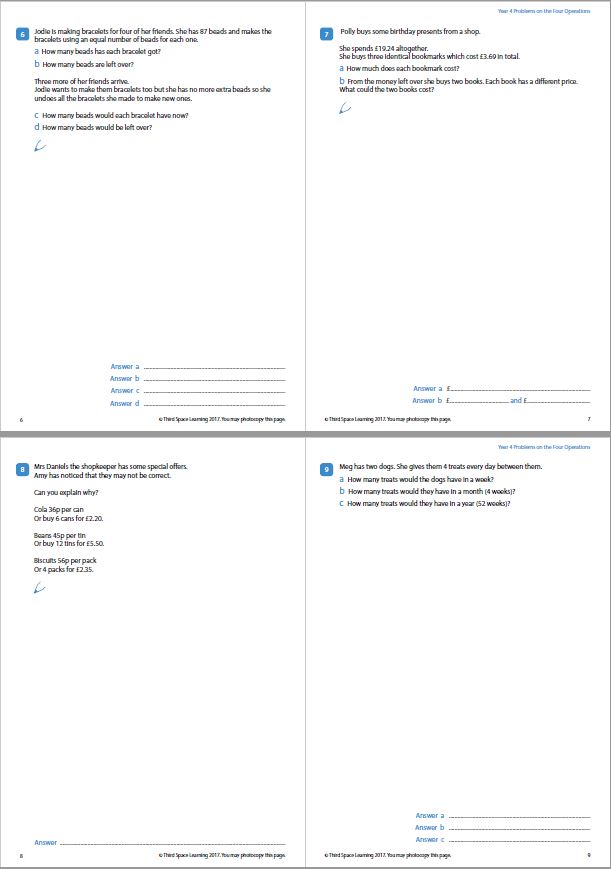
Example Year 4 word problem
- Lily, Simon and Rose are each thinking of a number. The sum of their numbers is 9,989. Lily’s number is 1,832. Simon’s number is three thousand more than Lily’s. What is Rose’s number? Answer: 3,325

- Mia has a jug with 2.5 litres of water in it. She pours two glasses of 300ml and three glasses of 500ml. How much water is left in the jug? Give your answer in millilitres. Answer: 400ml
Multi-step word problems: Year 5
Although one and two-step word problems are the mainstay of Year 5 reasoning and problem solving, word problems for year 5 are also when children may start to extend their range to include multi-step problems;
In Upper Key Stage 2, word problems become more complex not only in the calculations (higher numbers, decimals etc.) but also the vocabulary – a subtlety of maths language may mean it is less obvious as to which operation is required.
In the first example below, the children are essentially being asked to add and divide by 7 – or find the ‘mean’ – but the word problem doesn’t use the vocabulary children usually associate with addition or division, such as total, sum, share, split, etc. To reduce the cognitive demand of questions such as these, the numbers could be altered so that children are still required to extract the calculations from the word problems but can then complete those calculations with simpler numbers.
Example Year 5 multi-step word problems
- A writer is working on two projects. She has one week to write 518 maths questions for one project and 476 questions for another project. If she completes the same number of questions every day, how many should she aim to complete each day? Answer: 142
- Walton Wanderers’ new shirt costs £29. In the first month after it was launched, the club shop sold 1,573 shirts. 54 shirts were returned because they did not fit. How much money did the club shop receive by selling the shirts? Answer: £44,051
Multi-step word problems Year 6
With word problems for year 6, children move on from 2-step word problems to multi-step word problems. These could include fractions, decimals and percentages. Some of the most complex problems in KS2 SATS papers are worth 3 marks – these are intended to challenge more able mathematicians.
As previously mentioned, one or two marks can be achieved for correctly solving different ‘steps’ of the problem even without arriving at the correct final answer.
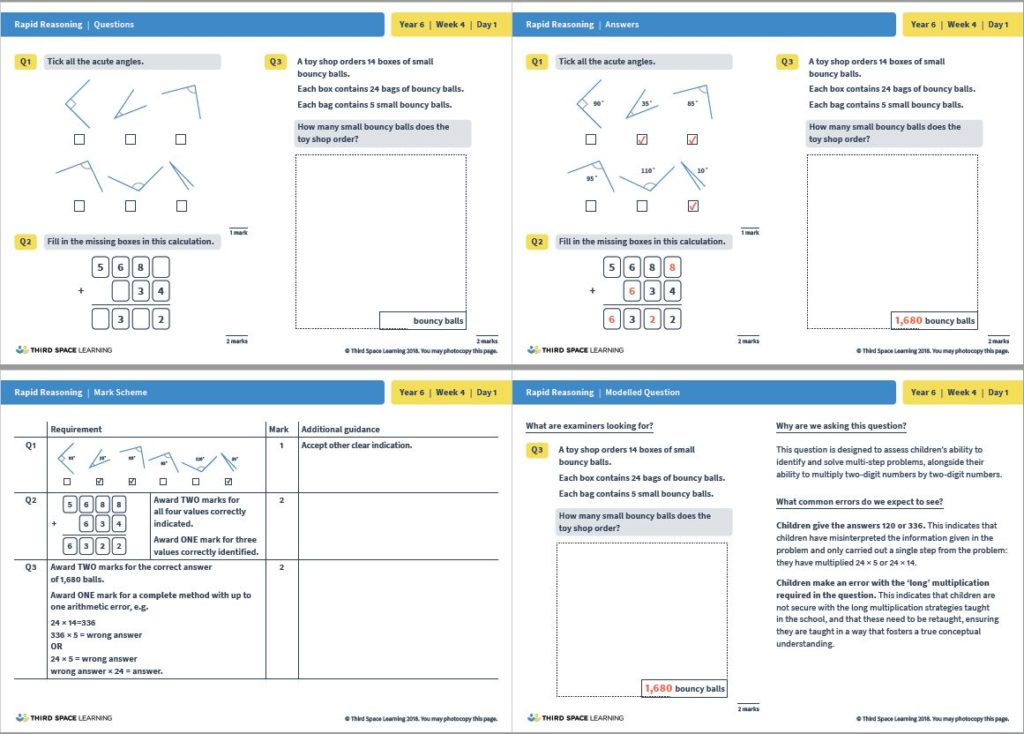
Example Year 6 multi-step word problem
- Sarah makes jewellery with beads. Bracelets have 37 beads. Necklaces have 74 beads. Sarah makes 28 bracelets and 81 necklaces. How many beads does she use altogether? Answer: 7,030
- A field measures 15m by 20m. The field next to it is 300cm longer and 2.5m narrower. What is the difference in area between the two fields? Answer: 15m
For more like this, please refer to this collection of 35 year 6 maths reasoning questions to support teaching in the run up to SATs or if you want to focus specifically on using the bar model as a problem solving tool, try these Year 6 bar model word problems.
2-step and multi-step word problems by topic
What follows are a series of 2-step word problems and multi-step worded problems based around the national curriculum objectives for each topic in maths. These show you a full range of question and problem types and the type of skills and knowledge your pupils will need to develop. We’ve also added some links to relevant word problems worksheets.
Year 3 to 6 Rapid Reasoning (Weeks 1-6)
Download 480 two-step and multi-step word problems for Years 3 to Year 6 (4 a day x 6 weeks for each year group)
Place value word problems
Place value problems appear throughout KS2. In Year 3, they will be based on five objectives:
- count from 0 in multiples of 4, 8, 50 and 100 (find 10 or 100 more or less than a given number)
- recognise the place value of each digit in a three-digit number
- compare and order numbers up to 1000
- identify, represent and estimate numbers using different representations
- read and write numbers up to 1000 in numerals and in words.
The progression in place value through KS2 ends in Year 6 with problems being based on three objectives:
- read, write, order and compare numbers up to 10 000 000 and determine the value of each digit
- round any whole number to a required degree of accuracy
- use negative numbers in context, and calculate intervals across zero.
Place value multi-step word problem: Year 6
- Mo uses four-digit cards and some zeros to make a seven-digit number on a place-value grid. Mo places the digit with the lowest value in the place with the highest value. He then places the 6 so that it has a value of 60,000. Finally, he places the digit with the highest value in the place with the lowest value. What could Mo’s number be? Write your answer in words.
- Answer: any of the following numbers: one million two hundred and sixty thousand and nine, one million sixty-two thousand and nine, one million sixty thousand two hundred and nine, one million sixty thousand and twenty-nine
For free multi-step word problems worksheets download these free number and place value word problems for Years 3, 4, 5 and 6
Addition and subtraction word problems
Addition and subtraction problems appear throughout KS2. In Year 3, they will be based on three objectives:
- add and subtract numbers mentally
- add and subtract numbers with up to three digits, using formal written methods of columnar addition and subtraction estimate the answer to a calculation and use inverse operations to check answers
- solve problems, including missing number problems, using number facts, place value, and more complex addition and subtraction.
The progression in addition and subtraction through KS2 ends in Year 6 with problems being based on three objectives:
- perform mental calculations, including with mixed operations and large numbers
- solve addition and subtraction multi-step problems in contexts, deciding which operations and methods to use and why
- use estimation to check answers to calculations and determine, in the context of a problem, an appropriate degree of accuracy.
Addition and subtraction multi-step word problem: Year 6
- Buzzard Sky Diving Company have taken individual bookings worth £12,584 and group bookings worth £15,992. Some people have cancelled at the last minute. £1,629 has had to be returned to them. How much money has the sky diving company taken altogether? Answer: £26,947
For free multi-step and two-step word problems worksheets download these free addition and subtraction word problems for Years 3, 4, 5 and 6 and take a look at our collection of addition and subtraction word problems for Year 3- Year 6.
Tips for solving addition multi-step word problems
Children should be taught to recognise the vocabulary used in addition word problems to signify that the addition operation is required, for example, altogether, combined, total, sum etc. Be mindful that although more can be used for addition (e.g. What is 7 more than 9?), it can also be used for subtraction (e.g. How many more is 9 than 7?).
Addition multi-step word problem: Year 6
- Two different numbers add together to make an even total less than 20. Both numbers are greater than 6 and less than 12. What could the numbers be? Answer: 7 and 9, 7 and 11, 8 and 10
Tips for solving subtraction multi-step word problems
Children should be taught to recognise the vocabulary used in subtraction word problems to signify that the subtraction operation is required, for example, change (money), difference, fewer than, minus etc. They should also by now know their subtraction facts.
Subtraction two-step word problem: Year 5
- Carlos Varqueri – United’s star striker – has asked for a pay rise. He would like another £154,875 a year, so that his wage becomes £800,000 per year. How much money does Carlos earn at the moment? Answer: £645,125
Multiplication and division word problems
Multiplication and division problems appear throughout KS2. In Year 3, they will be based on three objectives:
- recall and use multiplication and division facts for the 3, 4 and 8 multiplication tables
- write and calculate mathematical statements for multiplication and division using the multiplication tables that they know, including for two-digit numbers times one-digit numbers, using mental and progressing to formal written methods
- solve problems, including missing number problems, involving multiplication and division, including positive integer scaling problems and correspondence problems in which n objects are connected to m objects.
The progression in multiplication and division through KS2 ends in Year 6 with problems being based on six objectives:
- multiply multi-digit numbers up to 4 digits by a two-digit whole number using the formal written method of long multiplication
- divide numbers up to 4 digits by a two-digit whole number using the formal written method of long division, and interpret remainders as whole number remainders, fractions, or by rounding, as appropriate for the context
- divide numbers up to 4 digits by a two-digit number using the formal written method of short division where appropriate, interpreting remainders according to the context
- perform mental calculations, including with mixed operations and large numbers
- identify common factors, common multiples and prime numbers
- use estimation to check answers to calculations and determine, in the context of a problem, an appropriate degree of accuracy.
Multiplication and division multi-step word problem: Year 6 (crossover with decimals)
- Lottie is playing a computer game. She has scored 67 points so far. She defeats a giant, which means that her score becomes ten times greater. However, she then gets lots in a maze, which means that her score becomes 1,000 times smaller. What is Lottie’s new score? Answer: 0.67
Tips for solving multiplication multi-step word problems
Children should be taught to recognise the vocabulary used in word problems to signify that the multiplication operation is required, for example, product, double, triple, groups etc. Be mindful that groups can be used in both multiplication and division problems, e.g. ‘What are 7 groups of 5?’ (multiplication) or ‘How many groups of 4 fit into 28?’ (division).
Multiplication multi-step word problem: Year 6
- There are 32 levels in a computer game. The maximum number of points that can be achieved for each level is 1,450. Hauwa completes the game and scores maximum points. How many points does Hauwa score altogether? Answer: 46,400
For free multi-step and two-step word problems worksheets download free multiplication word problems worksheets for Years 3, 4, 5 and 6
Children can practice can practice multiplication word problems in Third Space Learning’s online tuition programmes.
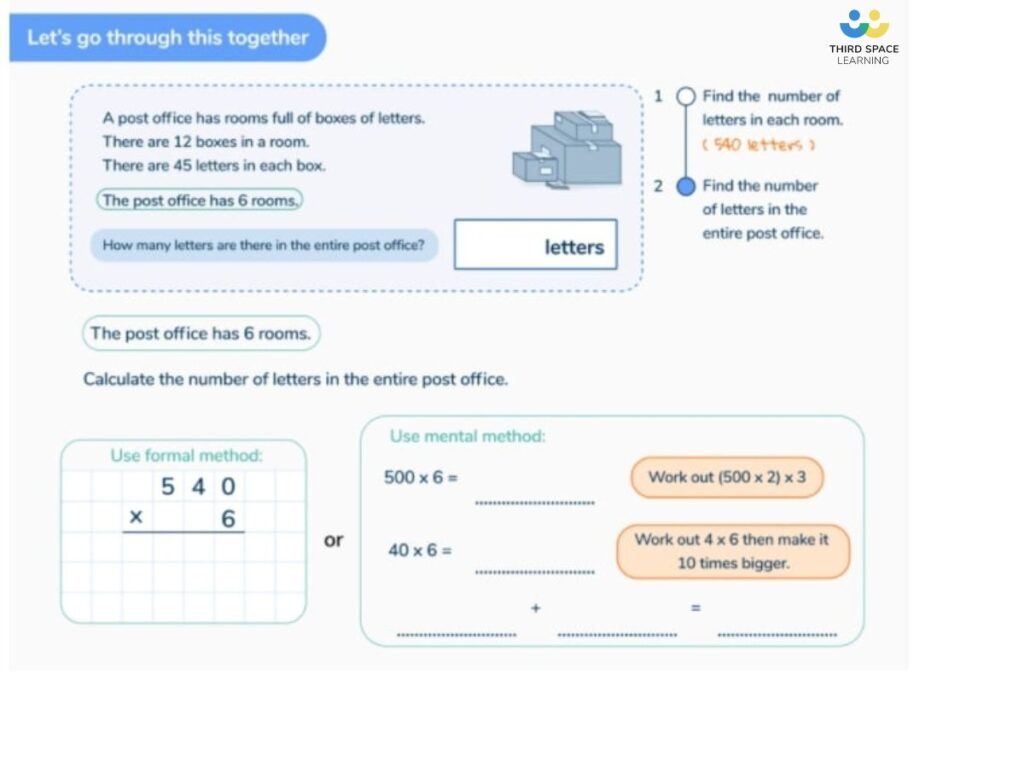
Tips for solving division multi-step word problems
Children should be taught to recognise the vocabulary used in division word problems to signify that the division operation is required, for example, halve, share, groups, split etc.
Division two-step word problem: Year 4
- A group of friends earn £120 by mowing lawns. They share the money equally. They get £15 each. How many friends are there in the group? Answer: 8
For free multi-step and two-step word problems worksheets download this free division word problems worksheet for Years 3, 4, 5 and 6
Mixed operations word problems
In the Year 3 non-statutory notes and guidance of the National Curriculum, it is recommended that pupils practise solving varied addition and subtraction questions and simple multiplication and division problems in contexts, deciding which of the four operations to use and why. These include measuring and scaling contexts, and correspondence problems in which m objects are connected to n objects.
At the end of KS2, the guidance states that pupils could practise addition, subtraction, multiplication and division for larger numbers, using the formal written methods of columnar addition and subtraction, short and long multiplication, and short and long division.
Mixed operations two-step word problem: Year 6 (crossover with money)

- A customer visits Dave’s DIY and buys 18 packs of screws, 18 packs of washers and a screwdriver. How much change is given from £20? Answer: £1.67
Four operations multi-step word problem: Year 5
- Oakthorpe Academy have been given a donation of £5,460 by the PTA. The School Council decide to use £1,755 on buying some new computer equipment. The rest is split equally between five year groups so they can decide for themselves how to spend the money. How much money will each year group have? Answer: £741
Read more
- 33 mental maths strategies you should be teaching in KS1 and KS2
- What are number facts? Activities to support memorisation.
- How primary schools develop fluency in maths
Fraction word problems
Fraction word problems require a good understanding of division and multiplication. Bar models or other pictorial representations are useful strategies in helping children solve problems like these.
Fraction problems appear throughout KS2. In Year 3, they will be based on seven objectives:
- count up and down in tenths
- recognise that tenths arise from dividing an object into 10 equal parts and in dividing one-digit numbers or quantities by 10
- recognise, find and write fractions of a discrete set of objects: unit fractions and non-unit fractions with small denominators
- recognise and use fractions as numbers: unit fractions and non-unit fractions with small denominators
- recognise and show, using diagrams, equivalent fractions with small denominators
- add and subtract fractions with the same denominator within one whole
- compare and order unit fractions, and fractions with the same denominators.
The progression in fractions through KS2 ends in Year 6 with problems being based on seven objectives:
- use common factors to simplify fractions and use common multiples to express fractions in the same denomination
- compare and order fractions, including fractions > 1
- add and subtract fractions with different denominators and mixed numbers, using the concept of equivalent fractions
- multiply simple pairs of proper fractions, writing the answer in its simplest form
- divide proper fractions by whole numbers
- associate a fraction with division and calculate decimal fraction equivalents
- recall and use equivalences between simple fractions, decimals and percentages, including in different contexts.
Fraction multi-step word problem: Year 6
- A bakery has 2 and 1/3 rhubarb pies left for sale. A customer buys 3/12 of a pie. What fraction of the pies is left? Write your answer as a mixed number. Answer: 2 and 1/12
For free multi-step and two-step word problems worksheets download fractions and decimals word problems for Years 3, 4, 5 and 6
Decimals word problems
Decimal word problems are commonly used in questions involving money, although they also often appear alongside fractions and/or percentages, requiring children to calculate their equivalences.
Decimal problems begin in Year 4 and will be based on six objectives:
- recognise and write decimal equivalents of any number of tenths or hundredths
- recognise and write decimal equivalents to ¼, ½, ¾
- find the effect of dividing a one- or two-digit number by 10 and 100, identifying the value of the digits in the answer as ones, tenths and hundredths
- round decimals with one decimal place to the nearest whole number
- compare numbers with the same number of decimal places up to two decimal places; solve simple measure and money problems involving fractions and decimals to two decimal places.
The progression in decimals from Year 4 ends in Year 6 with problems being based on six objectives
- associate a fraction with division and calculate decimal fraction equivalents for a simple fraction
- identify the value of each digit in numbers given to three decimal places and multiply and divide numbers by 10, 100 and 1000 giving answers up to three decimal places
- multiply one-digit numbers with up to two decimal places by whole numbers
- use written division methods in cases where the answer has up to two decimal places; solve problems which require answers to be rounded to specified degrees of accuracy
- recall and use equivalences between simple fractions, decimals and percentages, including in different contexts.
Decimals two-step word problem: Year 6 (crossover with multiplication)
- A teaspoon contains 5.26ml of cough medicine. Amber takes 5 teaspoons full every day. How many millilitres of cough medicine does Amber take each day? Answer: 26.3ml
Percentage word problems
Children need a secure understanding in fractions before attempting percentage problems; they are therefore not introduced until Upper Key Stage 2. Percentage word problems begin in Year 5 and will be based on two objectives:
- recognise the per cent symbol (%) and understand that per cent relates to ‘number of parts per hundred’, and write percentages as a fraction with denominator 100, and as a decimal
- solve problems which require knowing percentage and decimal equivalents of ½, ¼, 1/5, 2/5, 4/5 and those fractions with a denominator of a multiple of 10 or 25.
The progression in percentage continues into Year 6 with problems being based on two objectives:
- recall and use equivalences between simple fractions, decimals and percentages, including in different contexts
- solve problems involving the calculation of percentages and the use of percentages for comparison.
Percentage multi-step word problem: Year 6
- Rachel and Max are playing a computer game. The game has 160 levels. Rachel’s counter says she has completed 60% of the game. Max’s counter says that he has completed 45% of the game. What levels are they each on? Answer: Rachel = Level 96, Max = Level 72
For free multi-step and two-step word problems worksheets download decimals and percentages word problems for Years 3, 4, 5 and 6
Measurement word problems
Many measurement word problems require children to convert between metric measures, thus children should be confident in multiplying and dividing by powers of 10. More complex measurement word problems (such as those involving imperial measures) may require children to have an understanding of ratio and proportion.
Word problems involving measures begin in Year 3 and will be based on six objectives:
- measure, compare, add and subtract: lengths (m/cm/mm); mass (kg/g), volume/capacity (l/ml)
- time word problems where children tell and write the time from an analogue clock, including using Roman numerals from I to XII, and 12-hour and 24-hour clocks
- estimate and read time with increasing accuracy to the nearest minute
- record and compare time in terms of seconds, minutes and hours
- use vocabulary such as o’clock, a.m./p.m., morning, afternoon, noon and midnight
- know the number of seconds in a minute and the number of days in each month, year and leap year; compare durations of events
The progression continues into Year 6 with problems being based on three objectives:
- solve problems involving the calculation and conversion of units of measure, using decimal notation up to three decimal places where appropriate
- use, read, write and convert between standard units, converting measurements of length, mass, volume and time from a smaller unit of measure to a larger unit, and vice versa, using decimal notation to up to three decimal places
- convert between miles and kilometres.
Measurement multi-step word problem: Year 6 (crossover with ratio)
- 5 miles are approximately equivalent to 8 km. Mr Norton’s car speedometer shows that he is travelling at 104 km/h. About how many miles per hour (mph) is the car travelling? Answer: 65 mph
Money word problems
Problems involving money link with decimals (money notation) and measures (converting between £ and p). Where possible, especially until their understanding is secure, children should be handling real money to help them solve problems.
Money word problems begin in Year 3 and will be based on one objective: add and subtract amounts of money to give change, using both £ and p in practical contexts. The non-statutory guidance in the curriculum recommends that pupils continue to become fluent in recognising the value of coins, by adding and subtracting amounts, including mixed units, and giving change using manageable amounts.
The decimal recording of money is introduced formally in year 4, where word problems will be based on one objective: solve simple measure and money problems involving fractions and decimals to two decimal places.
Money problems continue throughout KS2 but are not specifically mentioned in the National Curriculum beyond Year 4.
Two-step money word problem: Year 6 (crossover with mixed operations)
These are the different prices of tickets at a cinema.

- Jamaal’s dad buys two adults’ tickets and four children’s tickets. How much money do the tickets cost altogether? Answer: £32.20
Area word problems
Mathematical questions related to area require a secure understanding of arrays, times tables, multiplication, division and factors. Concrete resources such as Numicon and multilink can be used to support children to solve these problems.
Word problems involving area begin in Year 4 and will be based on one objective: find the area of rectilinear shapes by counting squares. The progression continues into Year 6 with problems being based on three objectives:
- recognise that shapes with the same areas can have different perimeters and vice versa
- recognise when it is possible to use formulae for area and volume of shapes
- calculate the area of parallelograms and triangles
Area multi-step word problem: Year 6
- A square has a side length of 6cm. A triangle has a base of 8cm and a perpendicular height of 7cm. What is the difference in their areas? Answer: 8cm2
Perimeter word problems
As well as being an important life skill, it is important for children to be able to measure accurately with a ruler for some aspects of this mathematical strand. As above, Numicon and multilink are extremely useful resources in supporting children in their calculation of perimeter word problems.
These problems begin in Year 3 and will be based on one objective: measure the perimeter of simple 2-D shapes. The progression continues into Year 6 with problems being based on one objective: recognise that shapes with the same areas can have different perimeters and vice versa.
Perimeter word problem: Year 6 (crossover with decimals and multiplication)
- Josh has drawn a square. Each side is 7.5cm. What is the perimeter of the square? Answer: 30cm
Ratio word problems
In my experience, ratio is most successful when taught with concrete resources such as multilink, Cuisenaire rods or beads. Once children are taught how to represent ratio word problems using equipment (and eventually transferring to a pictorial representation, such as a bar model), the process is a lot easier.
Children won’t encounter ratio word problems until Year 6, where they will be based on three objectives:
- solve problems involving the relative sizes of two quantities where missing values can be found by using integer multiplication and division facts
- solve problems involving similar shapes where the scale factor is known or can be found
- solve problems involving unequal sharing and grouping using knowledge of fractions and multiples
Ratio word problem: Year 6 (crossover with measurement)
- A local council has spent the day painting double yellow lines. They use 1 pot of yellow paint for every 100m of road they paint. How many pots of paint will they need to paint a 2km stretch of road? Answer: 20 pots
Order of operations word problems
Children won’t encounter word problems about the order of operations until Year 6, where they will be based on one objective: use knowledge of the order of operations to carry out calculations involving the four operations. The non-statutory guidance in the National Curriculum also recommends that children explore the order of operations using brackets (otherwise known as BODMAS or BIDMAS); for example, 2 + 1 x 3 = 5 and (2 + 1) x 3 = 9.
Bodmas word problem: Year 6
- Draw a pair of brackets in one of these calculations so that they make two different answers. What are the answers?
- 50 – 10 × 5 =
- 50 – 10 × 5 =
Volume word problems
Children won’t encounter volume-related word problems until Year 6, where they will be based on two objectives:
- recognise when it is possible to use formulae for area and volume of shapes
- calculate, estimate and compare volume of cubes and cuboids using standard units, including cubic centimetres and cubic metres, and extending to other units
Volume word problem: Year 6
This large cuboid has been made by stacking shipping containers on a boat. Each individual shipping container has a length of 6m, a width of 4m and a height of 3m. What is the volume of the large cuboid? Answer: 864m3
Algebra word problems
Again algebra word problems only really come up in Year 6; the objectives they will be based on are:
- use simple formulae
- generate and describe linear number sequences
- express missing number problems algebraically
- find pairs of numbers that satisfy an equation with 2 unknowns
- enumerate possibilities of combinations of 2 variables
Algebra word problem: Year 6
This question is from the 2018 KS2 SATs paper. It is worth 2 marks as there are 2 parts to the answer.
Amina is making designs with two different shapes. She gives each shape a value. Calculate the value of each shape.
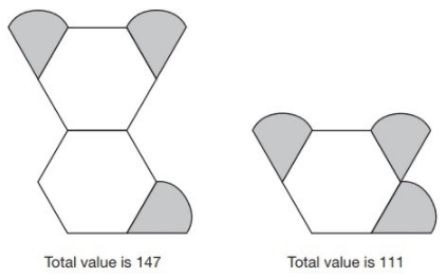
Answer: 36 (hexagon) and 25.
More support with KS2 word problems
For more multi-step and 2-step word problems register for free on the Third Space Learning Maths Hub which includes lots more printable word problems worksheets including as part of the free resources on offer a complete set of place value word problems with answer sheets for Year 3 to Year 6: All Kinds of Word Problems on Number and Place Value
DO YOU HAVE STUDENTS WHO NEED MORE SUPPORT IN MATHS?
Skye – our AI maths tutor built by teachers – gives students personalised one-to-one lessons that address learning gaps and build confidence.
Since 2013 we’ve taught over 2 million hours of maths lessons to more than 170,000 students to help them become fluent, able mathematicians.
Explore our AI maths tutoring or find out about a primary school maths tutor for your school.



